Development of Australian Social Policies
VerifiedAdded on 2023/06/10
|9
|1795
|205
AI Summary
This report examines the development of social policies in Australia from 1890 to the 21st century, including the impacts of changes and limitations. It covers the wage regulation, neo-liberal reforms, and the shift towards employed families.
Contribute Materials
Your contribution can guide someone’s learning journey. Share your
documents today.
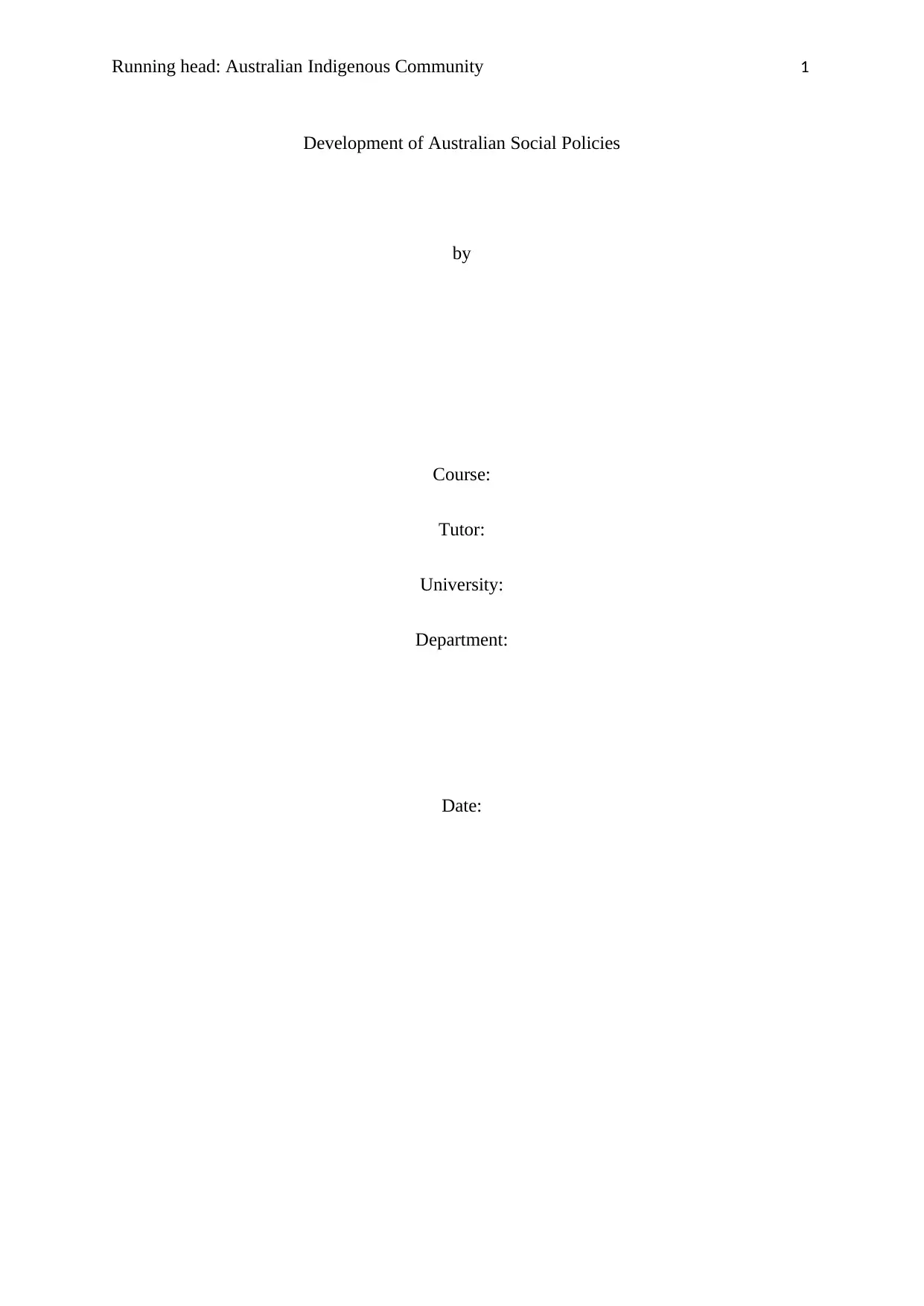
Running head: Australian Indigenous Community 1
Development of Australian Social Policies
by
Course:
Tutor:
University:
Department:
Date:
Development of Australian Social Policies
by
Course:
Tutor:
University:
Department:
Date:
Secure Best Marks with AI Grader
Need help grading? Try our AI Grader for instant feedback on your assignments.
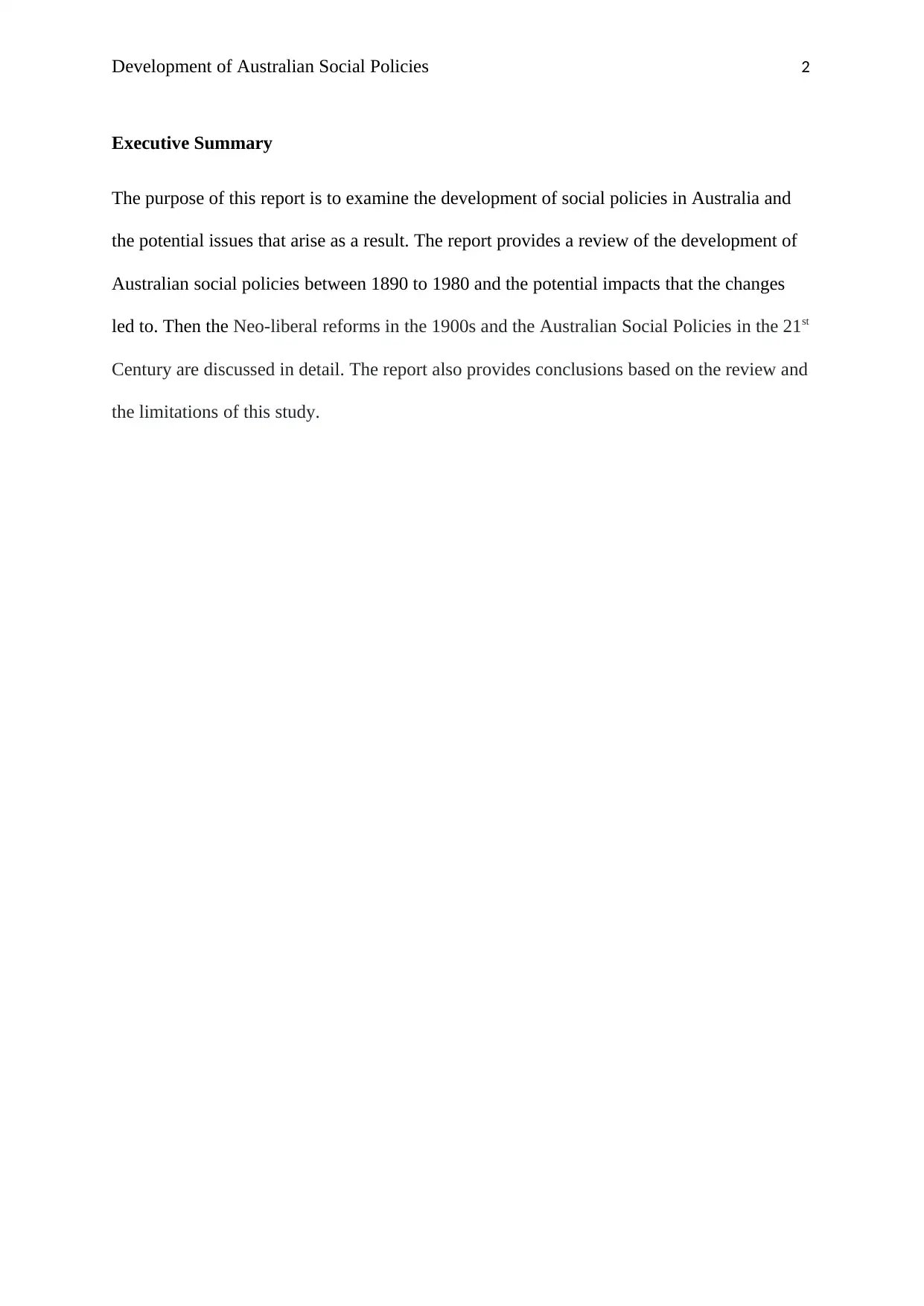
Development of Australian Social Policies 2
Executive Summary
The purpose of this report is to examine the development of social policies in Australia and
the potential issues that arise as a result. The report provides a review of the development of
Australian social policies between 1890 to 1980 and the potential impacts that the changes
led to. Then the Neo-liberal reforms in the 1900s and the Australian Social Policies in the 21st
Century are discussed in detail. The report also provides conclusions based on the review and
the limitations of this study.
Executive Summary
The purpose of this report is to examine the development of social policies in Australia and
the potential issues that arise as a result. The report provides a review of the development of
Australian social policies between 1890 to 1980 and the potential impacts that the changes
led to. Then the Neo-liberal reforms in the 1900s and the Australian Social Policies in the 21st
Century are discussed in detail. The report also provides conclusions based on the review and
the limitations of this study.
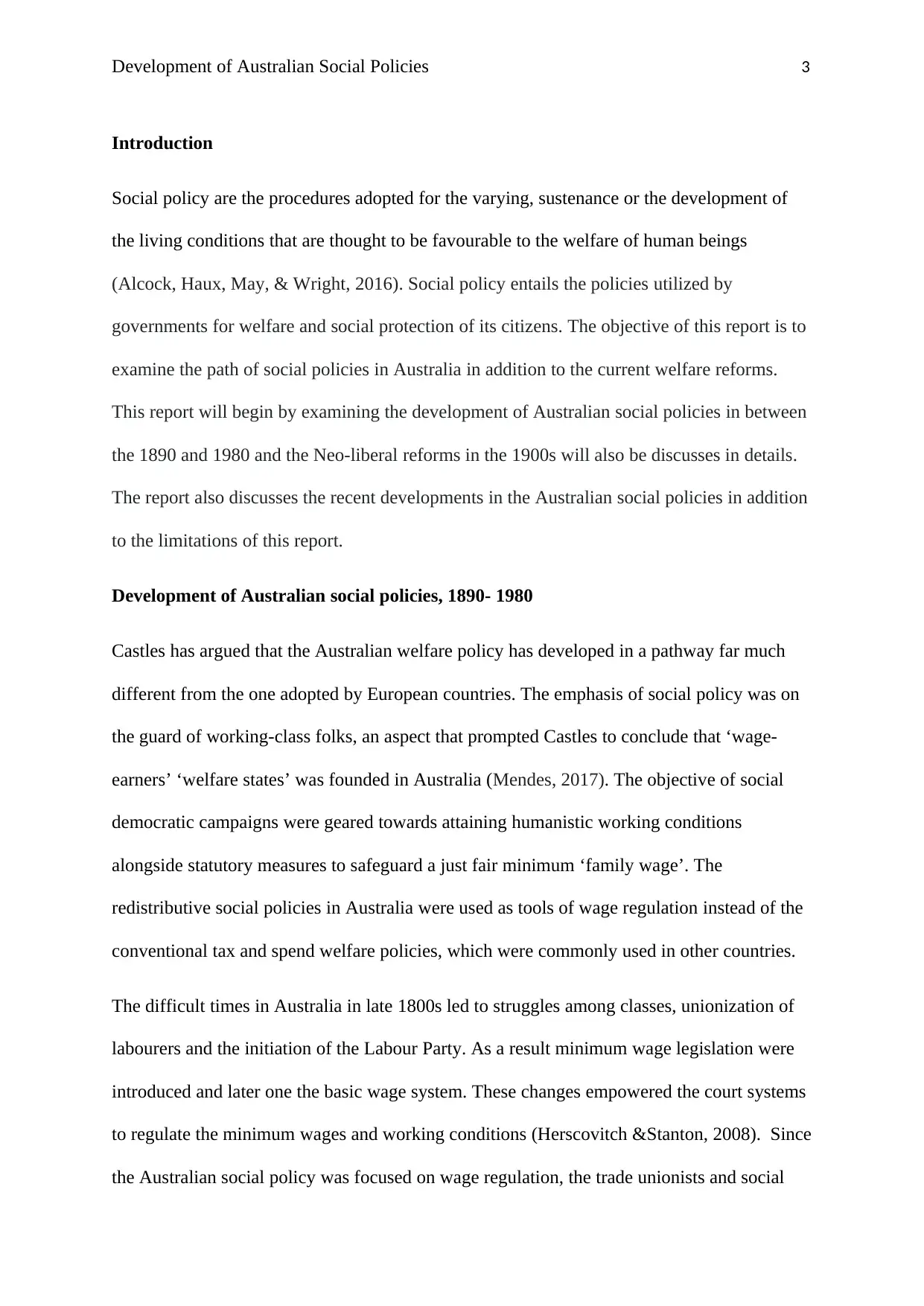
Development of Australian Social Policies 3
Introduction
Social policy are the procedures adopted for the varying, sustenance or the development of
the living conditions that are thought to be favourable to the welfare of human beings
(Alcock, Haux, May, & Wright, 2016). Social policy entails the policies utilized by
governments for welfare and social protection of its citizens. The objective of this report is to
examine the path of social policies in Australia in addition to the current welfare reforms.
This report will begin by examining the development of Australian social policies in between
the 1890 and 1980 and the Neo-liberal reforms in the 1900s will also be discusses in details.
The report also discusses the recent developments in the Australian social policies in addition
to the limitations of this report.
Development of Australian social policies, 1890- 1980
Castles has argued that the Australian welfare policy has developed in a pathway far much
different from the one adopted by European countries. The emphasis of social policy was on
the guard of working-class folks, an aspect that prompted Castles to conclude that ‘wage-
earners’ ‘welfare states’ was founded in Australia (Mendes, 2017). The objective of social
democratic campaigns were geared towards attaining humanistic working conditions
alongside statutory measures to safeguard a just fair minimum ‘family wage’. The
redistributive social policies in Australia were used as tools of wage regulation instead of the
conventional tax and spend welfare policies, which were commonly used in other countries.
The difficult times in Australia in late 1800s led to struggles among classes, unionization of
labourers and the initiation of the Labour Party. As a result minimum wage legislation were
introduced and later one the basic wage system. These changes empowered the court systems
to regulate the minimum wages and working conditions (Herscovitch &Stanton, 2008). Since
the Australian social policy was focused on wage regulation, the trade unionists and social
Introduction
Social policy are the procedures adopted for the varying, sustenance or the development of
the living conditions that are thought to be favourable to the welfare of human beings
(Alcock, Haux, May, & Wright, 2016). Social policy entails the policies utilized by
governments for welfare and social protection of its citizens. The objective of this report is to
examine the path of social policies in Australia in addition to the current welfare reforms.
This report will begin by examining the development of Australian social policies in between
the 1890 and 1980 and the Neo-liberal reforms in the 1900s will also be discusses in details.
The report also discusses the recent developments in the Australian social policies in addition
to the limitations of this report.
Development of Australian social policies, 1890- 1980
Castles has argued that the Australian welfare policy has developed in a pathway far much
different from the one adopted by European countries. The emphasis of social policy was on
the guard of working-class folks, an aspect that prompted Castles to conclude that ‘wage-
earners’ ‘welfare states’ was founded in Australia (Mendes, 2017). The objective of social
democratic campaigns were geared towards attaining humanistic working conditions
alongside statutory measures to safeguard a just fair minimum ‘family wage’. The
redistributive social policies in Australia were used as tools of wage regulation instead of the
conventional tax and spend welfare policies, which were commonly used in other countries.
The difficult times in Australia in late 1800s led to struggles among classes, unionization of
labourers and the initiation of the Labour Party. As a result minimum wage legislation were
introduced and later one the basic wage system. These changes empowered the court systems
to regulate the minimum wages and working conditions (Herscovitch &Stanton, 2008). Since
the Australian social policy was focused on wage regulation, the trade unionists and social
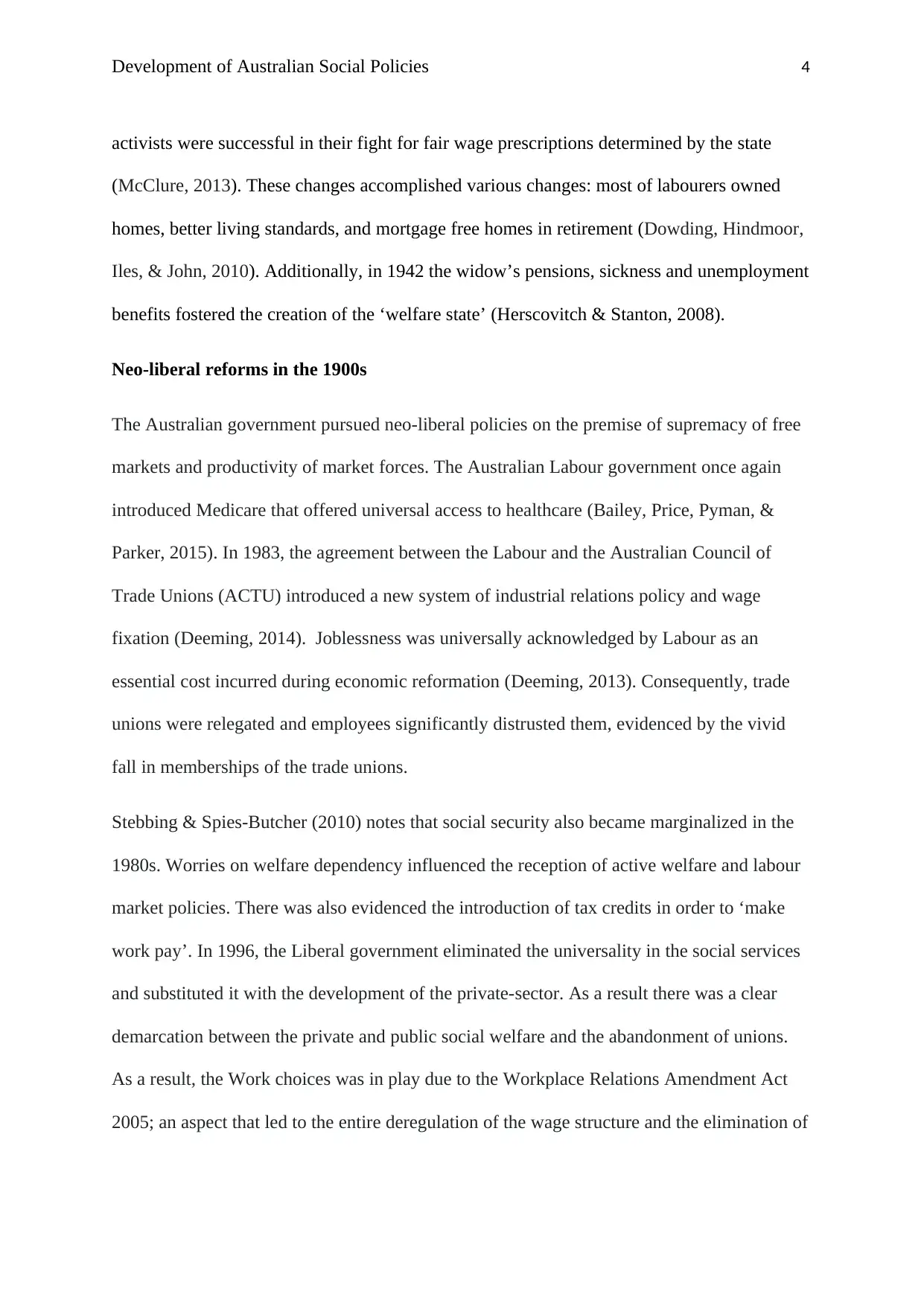
Development of Australian Social Policies 4
activists were successful in their fight for fair wage prescriptions determined by the state
(McClure, 2013). These changes accomplished various changes: most of labourers owned
homes, better living standards, and mortgage free homes in retirement (Dowding, Hindmoor,
Iles, & John, 2010). Additionally, in 1942 the widow’s pensions, sickness and unemployment
benefits fostered the creation of the ‘welfare state’ (Herscovitch & Stanton, 2008).
Neo-liberal reforms in the 1900s
The Australian government pursued neo-liberal policies on the premise of supremacy of free
markets and productivity of market forces. The Australian Labour government once again
introduced Medicare that offered universal access to healthcare (Bailey, Price, Pyman, &
Parker, 2015). In 1983, the agreement between the Labour and the Australian Council of
Trade Unions (ACTU) introduced a new system of industrial relations policy and wage
fixation (Deeming, 2014). Joblessness was universally acknowledged by Labour as an
essential cost incurred during economic reformation (Deeming, 2013). Consequently, trade
unions were relegated and employees significantly distrusted them, evidenced by the vivid
fall in memberships of the trade unions.
Stebbing & Spies-Butcher (2010) notes that social security also became marginalized in the
1980s. Worries on welfare dependency influenced the reception of active welfare and labour
market policies. There was also evidenced the introduction of tax credits in order to ‘make
work pay’. In 1996, the Liberal government eliminated the universality in the social services
and substituted it with the development of the private-sector. As a result there was a clear
demarcation between the private and public social welfare and the abandonment of unions.
As a result, the Work choices was in play due to the Workplace Relations Amendment Act
2005; an aspect that led to the entire deregulation of the wage structure and the elimination of
activists were successful in their fight for fair wage prescriptions determined by the state
(McClure, 2013). These changes accomplished various changes: most of labourers owned
homes, better living standards, and mortgage free homes in retirement (Dowding, Hindmoor,
Iles, & John, 2010). Additionally, in 1942 the widow’s pensions, sickness and unemployment
benefits fostered the creation of the ‘welfare state’ (Herscovitch & Stanton, 2008).
Neo-liberal reforms in the 1900s
The Australian government pursued neo-liberal policies on the premise of supremacy of free
markets and productivity of market forces. The Australian Labour government once again
introduced Medicare that offered universal access to healthcare (Bailey, Price, Pyman, &
Parker, 2015). In 1983, the agreement between the Labour and the Australian Council of
Trade Unions (ACTU) introduced a new system of industrial relations policy and wage
fixation (Deeming, 2014). Joblessness was universally acknowledged by Labour as an
essential cost incurred during economic reformation (Deeming, 2013). Consequently, trade
unions were relegated and employees significantly distrusted them, evidenced by the vivid
fall in memberships of the trade unions.
Stebbing & Spies-Butcher (2010) notes that social security also became marginalized in the
1980s. Worries on welfare dependency influenced the reception of active welfare and labour
market policies. There was also evidenced the introduction of tax credits in order to ‘make
work pay’. In 1996, the Liberal government eliminated the universality in the social services
and substituted it with the development of the private-sector. As a result there was a clear
demarcation between the private and public social welfare and the abandonment of unions.
As a result, the Work choices was in play due to the Workplace Relations Amendment Act
2005; an aspect that led to the entire deregulation of the wage structure and the elimination of
Secure Best Marks with AI Grader
Need help grading? Try our AI Grader for instant feedback on your assignments.
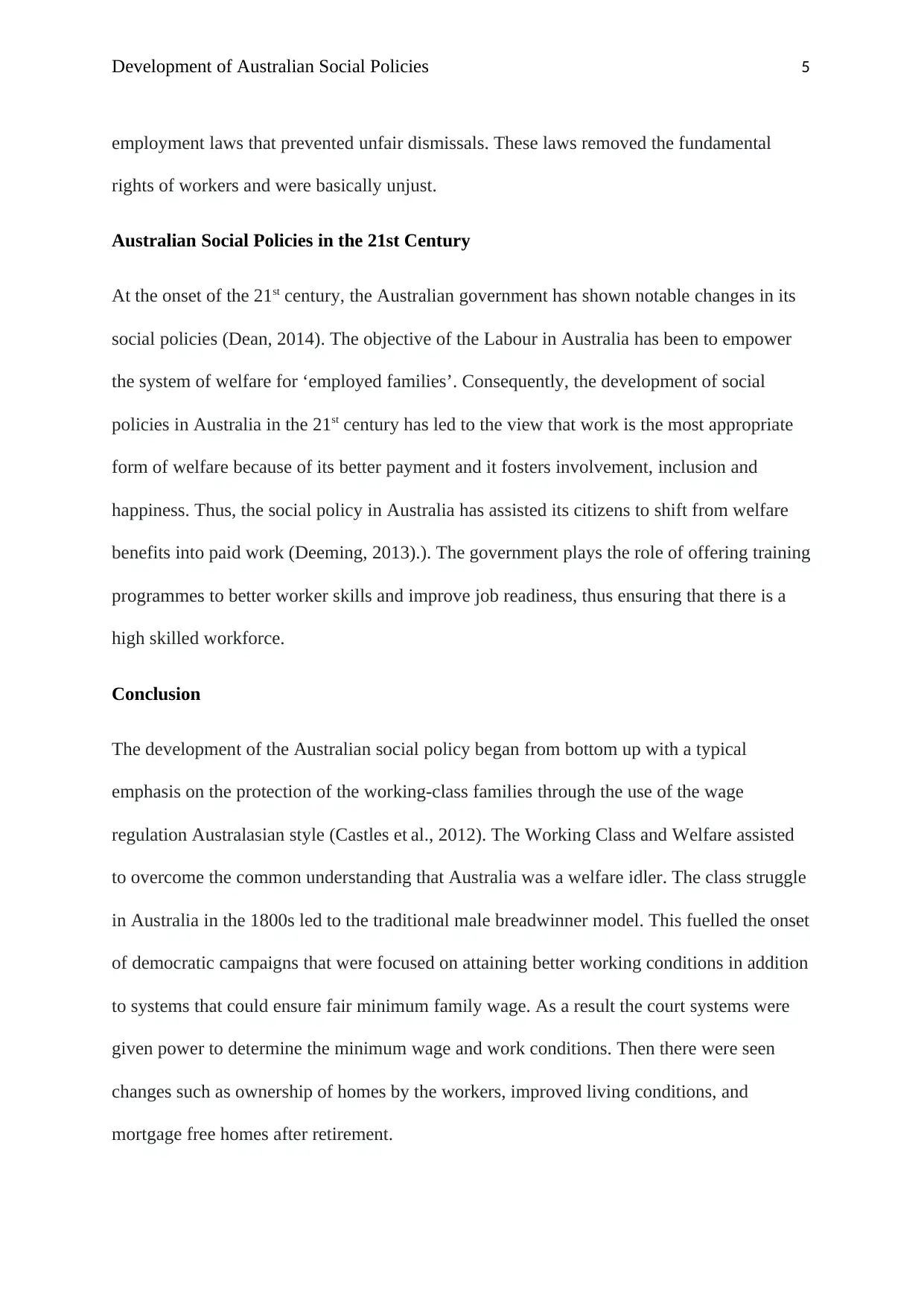
Development of Australian Social Policies 5
employment laws that prevented unfair dismissals. These laws removed the fundamental
rights of workers and were basically unjust.
Australian Social Policies in the 21st Century
At the onset of the 21st century, the Australian government has shown notable changes in its
social policies (Dean, 2014). The objective of the Labour in Australia has been to empower
the system of welfare for ‘employed families’. Consequently, the development of social
policies in Australia in the 21st century has led to the view that work is the most appropriate
form of welfare because of its better payment and it fosters involvement, inclusion and
happiness. Thus, the social policy in Australia has assisted its citizens to shift from welfare
benefits into paid work (Deeming, 2013).). The government plays the role of offering training
programmes to better worker skills and improve job readiness, thus ensuring that there is a
high skilled workforce.
Conclusion
The development of the Australian social policy began from bottom up with a typical
emphasis on the protection of the working-class families through the use of the wage
regulation Australasian style (Castles et al., 2012). The Working Class and Welfare assisted
to overcome the common understanding that Australia was a welfare idler. The class struggle
in Australia in the 1800s led to the traditional male breadwinner model. This fuelled the onset
of democratic campaigns that were focused on attaining better working conditions in addition
to systems that could ensure fair minimum family wage. As a result the court systems were
given power to determine the minimum wage and work conditions. Then there were seen
changes such as ownership of homes by the workers, improved living conditions, and
mortgage free homes after retirement.
employment laws that prevented unfair dismissals. These laws removed the fundamental
rights of workers and were basically unjust.
Australian Social Policies in the 21st Century
At the onset of the 21st century, the Australian government has shown notable changes in its
social policies (Dean, 2014). The objective of the Labour in Australia has been to empower
the system of welfare for ‘employed families’. Consequently, the development of social
policies in Australia in the 21st century has led to the view that work is the most appropriate
form of welfare because of its better payment and it fosters involvement, inclusion and
happiness. Thus, the social policy in Australia has assisted its citizens to shift from welfare
benefits into paid work (Deeming, 2013).). The government plays the role of offering training
programmes to better worker skills and improve job readiness, thus ensuring that there is a
high skilled workforce.
Conclusion
The development of the Australian social policy began from bottom up with a typical
emphasis on the protection of the working-class families through the use of the wage
regulation Australasian style (Castles et al., 2012). The Working Class and Welfare assisted
to overcome the common understanding that Australia was a welfare idler. The class struggle
in Australia in the 1800s led to the traditional male breadwinner model. This fuelled the onset
of democratic campaigns that were focused on attaining better working conditions in addition
to systems that could ensure fair minimum family wage. As a result the court systems were
given power to determine the minimum wage and work conditions. Then there were seen
changes such as ownership of homes by the workers, improved living conditions, and
mortgage free homes after retirement.
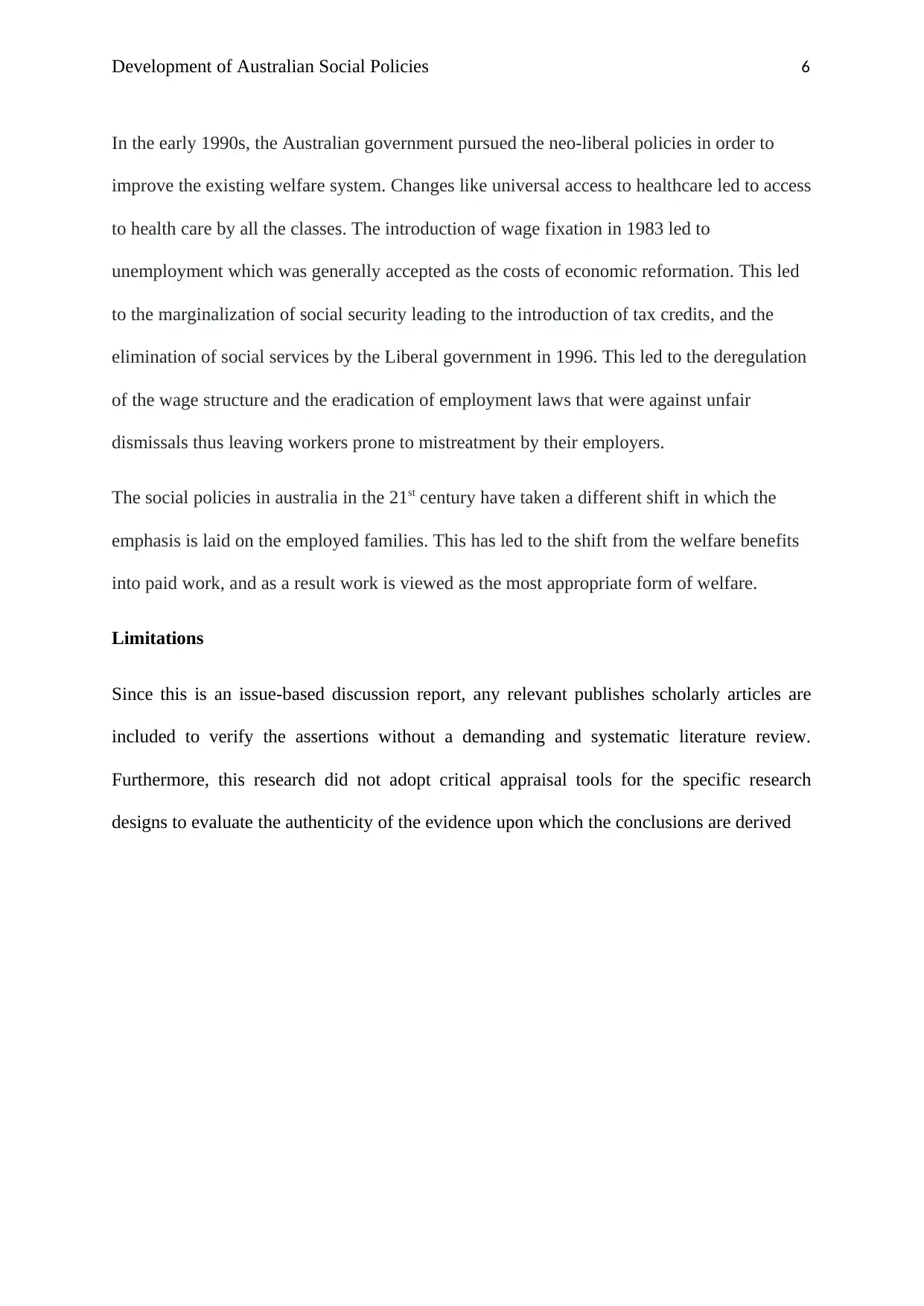
Development of Australian Social Policies 6
In the early 1990s, the Australian government pursued the neo-liberal policies in order to
improve the existing welfare system. Changes like universal access to healthcare led to access
to health care by all the classes. The introduction of wage fixation in 1983 led to
unemployment which was generally accepted as the costs of economic reformation. This led
to the marginalization of social security leading to the introduction of tax credits, and the
elimination of social services by the Liberal government in 1996. This led to the deregulation
of the wage structure and the eradication of employment laws that were against unfair
dismissals thus leaving workers prone to mistreatment by their employers.
The social policies in australia in the 21st century have taken a different shift in which the
emphasis is laid on the employed families. This has led to the shift from the welfare benefits
into paid work, and as a result work is viewed as the most appropriate form of welfare.
Limitations
Since this is an issue-based discussion report, any relevant publishes scholarly articles are
included to verify the assertions without a demanding and systematic literature review.
Furthermore, this research did not adopt critical appraisal tools for the specific research
designs to evaluate the authenticity of the evidence upon which the conclusions are derived
In the early 1990s, the Australian government pursued the neo-liberal policies in order to
improve the existing welfare system. Changes like universal access to healthcare led to access
to health care by all the classes. The introduction of wage fixation in 1983 led to
unemployment which was generally accepted as the costs of economic reformation. This led
to the marginalization of social security leading to the introduction of tax credits, and the
elimination of social services by the Liberal government in 1996. This led to the deregulation
of the wage structure and the eradication of employment laws that were against unfair
dismissals thus leaving workers prone to mistreatment by their employers.
The social policies in australia in the 21st century have taken a different shift in which the
emphasis is laid on the employed families. This has led to the shift from the welfare benefits
into paid work, and as a result work is viewed as the most appropriate form of welfare.
Limitations
Since this is an issue-based discussion report, any relevant publishes scholarly articles are
included to verify the assertions without a demanding and systematic literature review.
Furthermore, this research did not adopt critical appraisal tools for the specific research
designs to evaluate the authenticity of the evidence upon which the conclusions are derived
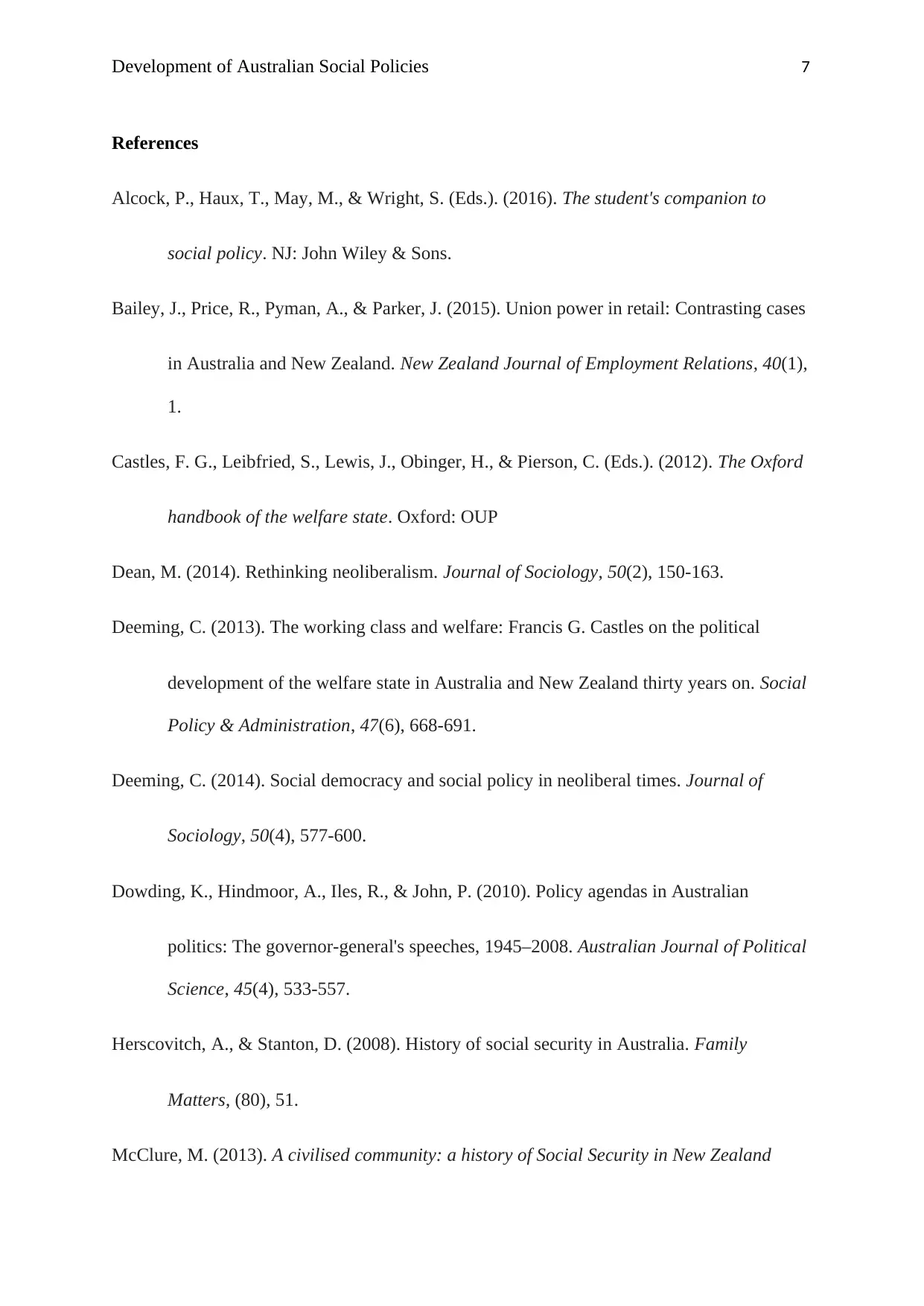
Development of Australian Social Policies 7
References
Alcock, P., Haux, T., May, M., & Wright, S. (Eds.). (2016). The student's companion to
social policy. NJ: John Wiley & Sons.
Bailey, J., Price, R., Pyman, A., & Parker, J. (2015). Union power in retail: Contrasting cases
in Australia and New Zealand. New Zealand Journal of Employment Relations, 40(1),
1.
Castles, F. G., Leibfried, S., Lewis, J., Obinger, H., & Pierson, C. (Eds.). (2012). The Oxford
handbook of the welfare state. Oxford: OUP
Dean, M. (2014). Rethinking neoliberalism. Journal of Sociology, 50(2), 150-163.
Deeming, C. (2013). The working class and welfare: Francis G. Castles on the political
development of the welfare state in Australia and New Zealand thirty years on. Social
Policy & Administration, 47(6), 668-691.
Deeming, C. (2014). Social democracy and social policy in neoliberal times. Journal of
Sociology, 50(4), 577-600.
Dowding, K., Hindmoor, A., Iles, R., & John, P. (2010). Policy agendas in Australian
politics: The governor-general's speeches, 1945–2008. Australian Journal of Political
Science, 45(4), 533-557.
Herscovitch, A., & Stanton, D. (2008). History of social security in Australia. Family
Matters, (80), 51.
McClure, M. (2013). A civilised community: a history of Social Security in New Zealand
References
Alcock, P., Haux, T., May, M., & Wright, S. (Eds.). (2016). The student's companion to
social policy. NJ: John Wiley & Sons.
Bailey, J., Price, R., Pyman, A., & Parker, J. (2015). Union power in retail: Contrasting cases
in Australia and New Zealand. New Zealand Journal of Employment Relations, 40(1),
1.
Castles, F. G., Leibfried, S., Lewis, J., Obinger, H., & Pierson, C. (Eds.). (2012). The Oxford
handbook of the welfare state. Oxford: OUP
Dean, M. (2014). Rethinking neoliberalism. Journal of Sociology, 50(2), 150-163.
Deeming, C. (2013). The working class and welfare: Francis G. Castles on the political
development of the welfare state in Australia and New Zealand thirty years on. Social
Policy & Administration, 47(6), 668-691.
Deeming, C. (2014). Social democracy and social policy in neoliberal times. Journal of
Sociology, 50(4), 577-600.
Dowding, K., Hindmoor, A., Iles, R., & John, P. (2010). Policy agendas in Australian
politics: The governor-general's speeches, 1945–2008. Australian Journal of Political
Science, 45(4), 533-557.
Herscovitch, A., & Stanton, D. (2008). History of social security in Australia. Family
Matters, (80), 51.
McClure, M. (2013). A civilised community: a history of Social Security in New Zealand
Paraphrase This Document
Need a fresh take? Get an instant paraphrase of this document with our AI Paraphraser
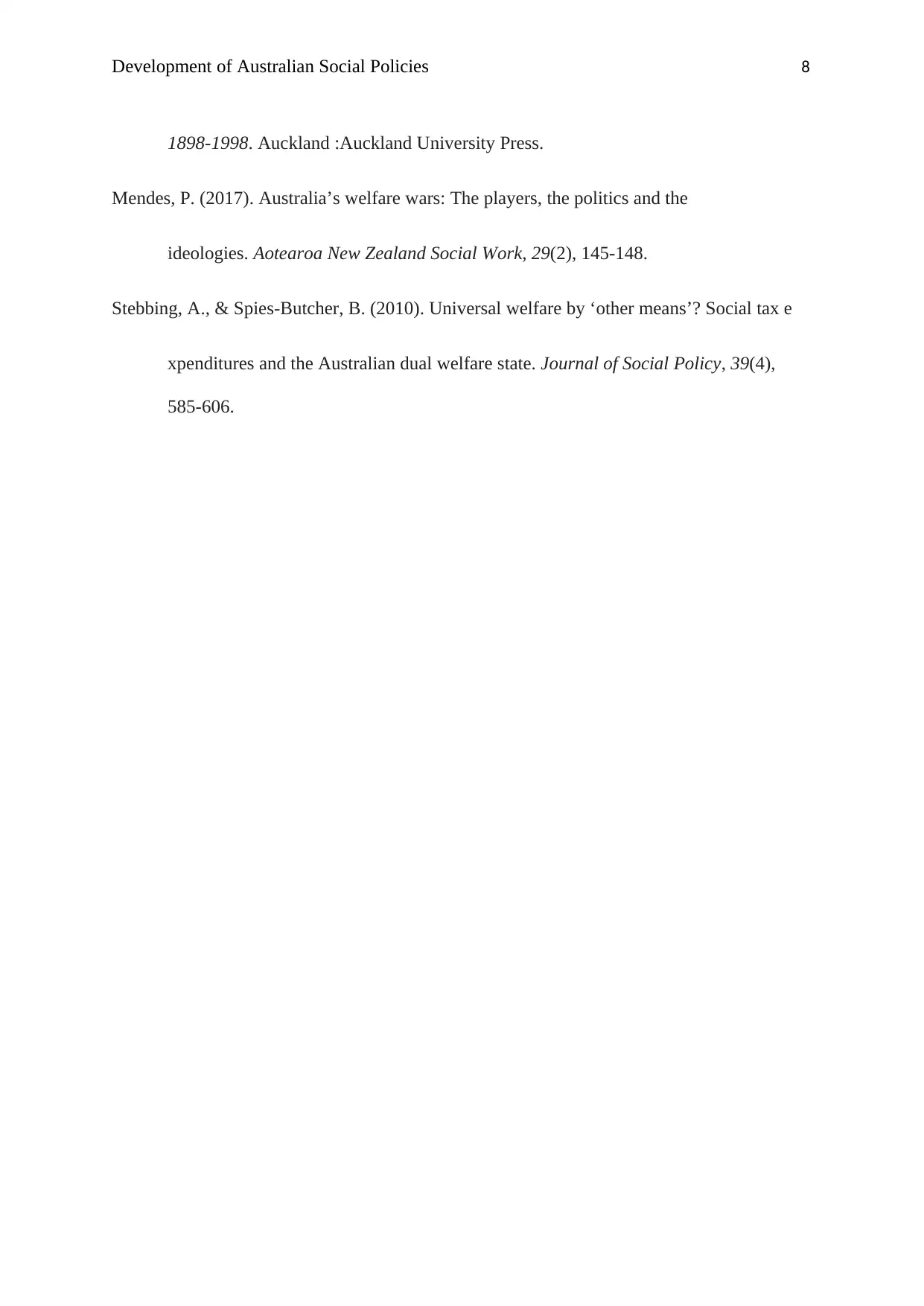
Development of Australian Social Policies 8
1898-1998. Auckland :Auckland University Press.
Mendes, P. (2017). Australia’s welfare wars: The players, the politics and the
ideologies. Aotearoa New Zealand Social Work, 29(2), 145-148.
Stebbing, A., & Spies-Butcher, B. (2010). Universal welfare by ‘other means’? Social tax e
xpenditures and the Australian dual welfare state. Journal of Social Policy, 39(4),
585-606.
1898-1998. Auckland :Auckland University Press.
Mendes, P. (2017). Australia’s welfare wars: The players, the politics and the
ideologies. Aotearoa New Zealand Social Work, 29(2), 145-148.
Stebbing, A., & Spies-Butcher, B. (2010). Universal welfare by ‘other means’? Social tax e
xpenditures and the Australian dual welfare state. Journal of Social Policy, 39(4),
585-606.
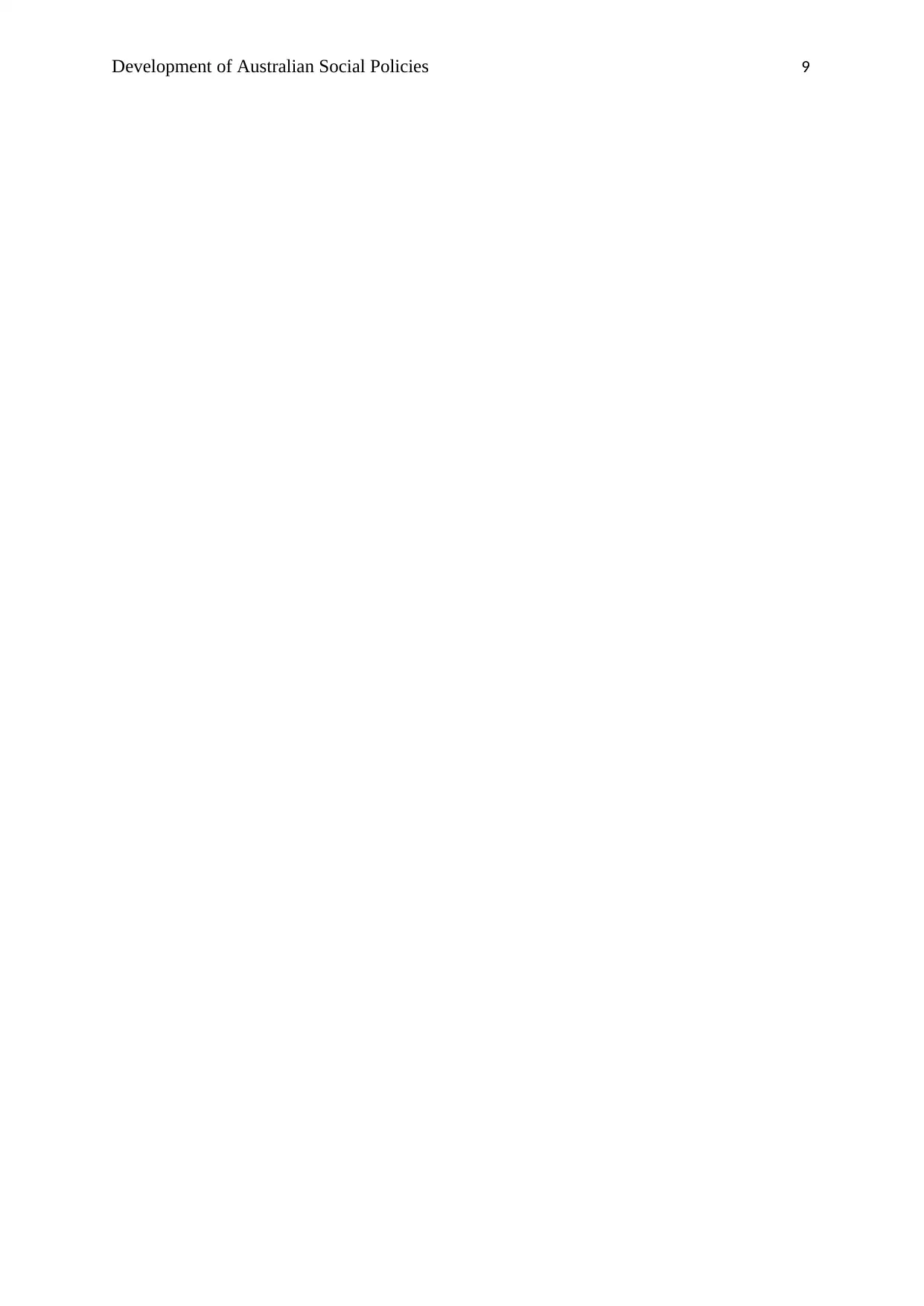
Development of Australian Social Policies 9
1 out of 9
Related Documents
Your All-in-One AI-Powered Toolkit for Academic Success.
+13062052269
info@desklib.com
Available 24*7 on WhatsApp / Email
![[object Object]](/_next/static/media/star-bottom.7253800d.svg)
Unlock your academic potential
© 2024 | Zucol Services PVT LTD | All rights reserved.





